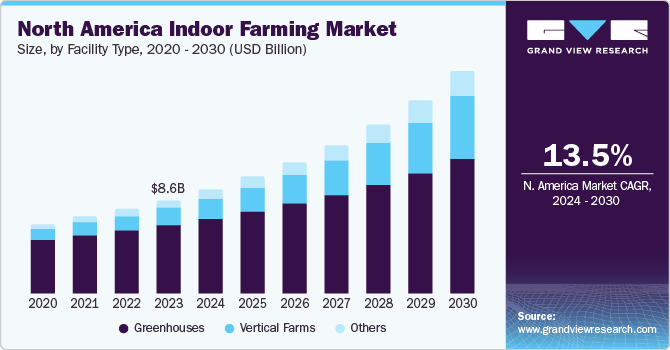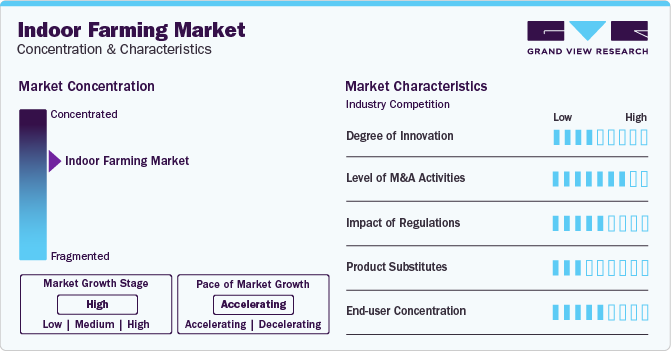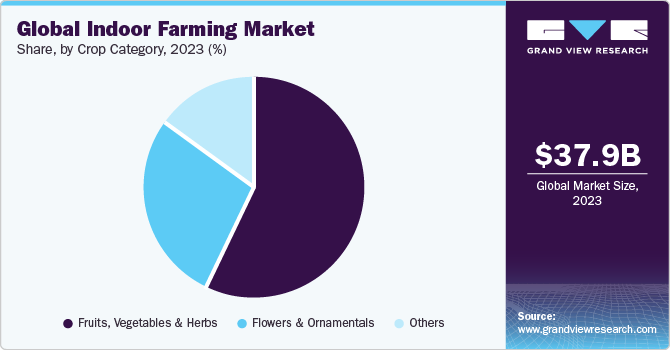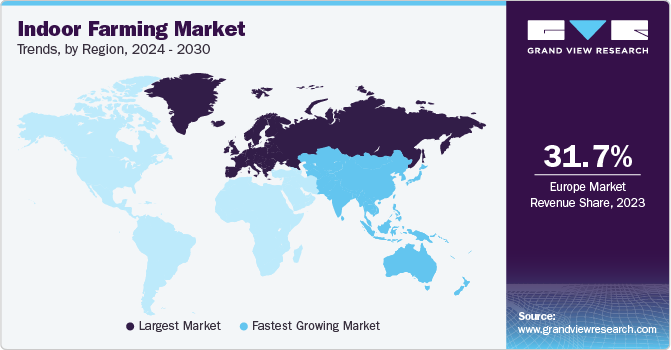- Home
- »
- Next Generation Technologies
- »
-
Indoor Farming Market Size, Share, Growth Report, 2030GVR Report cover
![Indoor Farming Market Size, Share & Trends Report]()
Indoor Farming Market Size, Share & Trends Analysis Report By Facility Type, By Component (Hardware, Software, and Services), By Growing Mechanism, By Crop Category, By Region, And Segment Forecasts, 2024 - 2030
- Report ID: GVR-3-68038-942-5
- Number of Report Pages: 120
- Format: PDF, Horizon Databook
- Historical Range: 2018 - 2021
- Forecast Period: 2023 - 2030
- Industry: Technology
Indoor Farming Market Size & Trends
The global indoor farming market size was valued at USD 37.9 billion in 2023 and is expected to grow at a compound annual growth rate (CAGR) of 13.2% from 2024 to 2030. Increasing consumer awareness regarding the advantages of consuming fresh and high-quality food is expected to drive the growth of the market. The rising population across the globe, especially in emerging economies such as China and India, has led to an increase in food demand, which, in turn, is expected to spur the growth of the market for indoor farming in the forthcoming years.

However, the changing climatic conditions contribute to existing environmental problems, such as soil degradation and groundwater depletion, affecting the food and agriculture production systems. Governments encourage building indoor farms along with other initiatives to overcome this problem, which, in turn, is expected to fuel the growth of the market. Organic foods are perceived as healthier, nutritious, safer, and more eco-friendly. A critical factor that influences the demand for organic food is the food purchasing behavior of consumers, which is essential for producers, policymakers, and suppliers to implement successful marketing strategies.
According to The World Bank Group, the overall arable land per capita has declined from 0.197 hectares in 2013 to 0.192 hectares in 2016. The scarcity of arable land owing to land degradation has urged the farmers to adopt new solutions to produce fresh food. The adoption of vertical farming techniques is expected to enable indoor farm owners to grow crops indoors in layers stacked on racks, in a multi-story building, or a warehouse. It is anticipated that this will emerge as a significant trend in the market by 2030.
Indoor farms help grow the total crop yield per unit area by using the stacked layers of potted seeds, thereby driving the market. Indoor farming is the practice of growing plants or crops indoors on a small and large scale. Indoor farming implements methods such as aquaponics and hydroponics and utilizes artificial lighting for adequate light levels and nutrients. However, the high initial investment in the building of indoor farms and limitations on the growing variety of crops is expected to hinder the market growth.
Europe held the largest market share in 2023, owing to the adoption of technologies for greenhouses and vertical farms. Developed countries such as the U.K., Germany, the U.S., and Canada are the rapid and early adopters of farming technologies. However, emerging economies such as India, China, Mexico, and Singapore are observing a substantial growth in the adoption of technologies integrated into indoor farms, owing to the rising demand for fresh crops. The increasing disposable income and urban population in the emerging economies have increased the consumption and demand for healthy, fresh, and nutritious food, which is projected to drive the indoor farming market.
Market Concentration & Characteristics
The market growth stage in the indoor farming market is high, and the pace of the market growth is accelerating. In the emerging stage, indoor farming technologies and practices are still relatively novel and gaining traction within the agricultural industry. Startups and early-stage companies are pioneering innovative approaches to indoor cultivation, experimenting with different crops, growing methods, and technology applications. Investment in research and development is high, with a focus on refining techniques, optimizing crop yields, and overcoming technical challenges.

Farming as a service market is also characterized by a high level of merger and acquisition (M&A) activity by the leading players. This is due to several factors, including the desire to gain high market share and the need to consolidate in a rapidly growing market.
While indoor farming offers unique advantages such as controlled environments and year-round production, substitutes such as outdoor farming methods may attract consumers attention for growing crops. Traditional outdoor farming remains a primary method for crop cultivation, especially for large-scale production of commodity crops like grains and oilseeds. Outdoor farming relies on natural sunlight, soil, and traditional irrigation methods.
Market concentration plays a pivotal role in the indoor farming market. While there is a diverse range of indoor farming companies operating globally, a handful of major players hold substantial influence and market presence.While the indoor farming market is characterized by a diverse array of players, market concentration exists among a select group of established companies that lead the industry in innovation, market share, and influence. However, the market remains dynamic, with opportunities for new entrants and disruptive technologies to challenge the dominance of incumbent players.
Facility Type Insights
The vertical farm segment is expected to exhibit the fastest CAGR from 2024 to 2030, owing to the growing adoption of eco-friendly production of fruits and vegetables. Besides, the changing food purchasing behavior of consumers resulting in an increasing demand for organic food is expected to drive the demand. Indoor farming protects crops from intense weather conditions using advanced techniques, such as the controlled environment agriculture technology, where the facilities use control of light, artificial environmental monitoring, and fertigation.
Farmers are implementing new crop production techniques, such as greenhouses and vertical farming, to meet rising food demand. The greenhouses facility type held the dominant market share in 2023. A greenhouse also called a hothouse, is a closed structure made up of transparent material and used to grow plants, crops, and flowers. In greenhouses, climatic conditions are controlled to enhance the quality and quantity of produce. Greenhouses also facilitate higher yield production than traditional farming techniques.
Component Insights
The hardware segment dominated the indoor farming component market in 2023 and is expected to remain dominant between 2024 and 2030, as hardware plays a significant role in maintaining the environment of indoor farms. The segment is further categorized into climate control systems, lighting systems, sensors, and irrigation systems, which enable the cultivation of indoor-grown crops. The climate control system is expected to be the fastest-growing segment during the forecast period, as it creates an environment conducive to plant growth. The system helps control the indoor climate with chillers, heaters, air-conditioning units, humidifiers, and air movement fans, among others.
The software segment is expected to exhibit a CAGR exceeding 15.4% between 2024 to 2030, owing to the upcoming trends in technologies and farming practices. The software traces the fruit and vegetables back to a grower, crop batch/patch, area of land/field, and supplier details. The segment has been further bifurcated into web-based and cloud-based software. The cloud-based software segment is estimated to register significant growth in the forthcoming years, as it collects millions of data points in real time, which can be examined with machine learning techniques to determine the changes in particular environmental parameters that affect the yield and taste of the final product.
Growing Mechanism Insights
The hydroponics segment registered a largest market share in 2023 and is expected to remain dominant over the between 2024 and 2030.Hydroponics is a popular farming method due to low installation costs and ease of operation. In this process the soil is replaced by a mineral solution inserted around the plant roots for growing plant. Hydroponics is promoted as a method to prevent climate change, to lessen environmental harm and species extinction brought on by overexploitation and intensive farming. Compared to the traditional soil grown production hydroponics benefit in efficient usage of water, facilitates a micro-climate, requires less labor, needs no soil, and produces higher quality food. Additionally, the hydroponics method eliminates the risk of soil organisms causing diseases. Growing awareness among consumers regarding the effects of pesticides is expected to boost the demand for hydroponics.
The aquaponics segment is anticipated to grow with a significant CAGR during the forecast period. Aquaponics is the combination of both hydroponics and aquaculture, which reduces the use of harmful chemicals for cultivation. The minimal water wasted compared to traditional farming is one of the major advantages of aquaponic agriculture. Aquaponics utilizes about 90% less water than conventional farming, despite the name's implication. Further, plants such as cucumbers, tomatoes, peppers, flowers, strawberries, melons, and herbs (mint, basil, wheatgrass, oregano, chives, sage, parsley) are grown through aquaponics.
Crop Category Insights
The fruits, vegetables, and herbs segment is expected to dominate the market for indoor farming between 2024 to 2030. The increasing production of commonly grown fruits, vegetables, and herbs such as tomatoes, lettuce, leafy greens, cucumbers, bell peppers, and chili peppers, is driving the segment growth. These crops are grown on a large scale and deliver maximum profit from their cultivation to the companies involved in their production. The tomato segment held the largest market share in 2023, as it is the major cultivated crop, owing to its rapid production rate.

The flowers and ornamentals segment is expected to contribute significantly to market growth during the forecast period. The segment accounted for more than 28.08% of the market share in 2023. The increasing use of flowers and ornamentals for decorative and aesthetic purposes is expected to drive market growth. The segment has been further segregated into perennials, annuals, and ornamentals. Ornamental flowers held the largest market share in 2023, owing to increasing sales.
Regional Insights
Europe held the largest market share of 31.71% in 2023 and is estimated to remain dominant during the forecast period. The rising adoption of technologies for indoor farms, such as Controlled Environment-Agriculture (CEA), which controls the environmental factor, is responsible for regional growth. Increasing focus on adopting technologies, such as active heat systems and LEDs, to improve the yield is driving the market. Several initiatives are undertaken by the regional government for building indoor farms to overcome challenges, such as growing population, climate change, and food production in an environmentally -unfriendly way. Farm owners are at the forefront of investing in technologies, such as LED lighting and crop monitoring sensors, which are expected to lower labor costs.

Asia Pacific is estimated to witness the fastest CAGR from 2024 to 2030. Countries such as China and Japan are estimated to witness considerable growth in the forthcoming years owing to the presence of many indoor farms. In addition, the continuously rising population in the region has resulted in an increasing demand for organic food, which has led to the building of greenhouses and vertical farms to produce crops. The rising awareness about the significance of alternative farming methods due to the availability of less fertile agricultural land is expected to further fuel regional demand.
U.K. Indoor Farming Market
The indoor farming market in the U.K. is expected to account for a significant revenue share in the Europe indoor farming market. The UK faces challenges related to limited arable land and changing climate conditions, making traditional outdoor farming less reliable. Indoor farming allows for year-round cultivation in controlled environments, overcoming seasonal limitations and maximizing land use efficiency.
Germany Indoor Farming Market
The indoor farming market in Germany is expected to account for a significant revenue share in the Europe indoor farming market. Indoor Farming in Germany has experienced steady growth in recent years, propelled by several factors including increasing consumer demand for locally grown, sustainable produce and advancements in agricultural technology.
France Indoor Farming Market
The indoor farming market in France is expected to account for a significant revenue share in the Europe indoor farming market. the UK indoor farming sector is poised for further growth and innovation, driven by technological advancements, changing consumer preferences, and the need for sustainable food production systems in the face of environmental challenges.
China Indoor Farming Market
The indoor farming market in China is expected to account for a significant revenue share in the Asia Pacific indoor farming market. Rapid urbanization in China has led to increased pressure on arable land, making traditional outdoor farming less viable. Indoor farming allows for cultivation in urban areas, utilizing vertical space and repurposing abandoned buildings for agricultural purposes.
India Indoor Farming Market
The indoor farming market in India is expected to account for a significant revenue share in the Asia Pacific indoor farming market. Concerns about food safety and security have prompted Indian consumers to seek out locally-grown, pesticide-free produce. Indoor farming provides a controlled environment where crops can be grown without the use of harmful chemicals, reducing the risk of contamination and ensuring food safety.
Japan Indoor Farming Market
The indoor farming market in Japan is expected to account for a significant revenue share in the Asia Pacific indoor farming market. The Japanese government has recognized the potential of indoor farming to enhance food security, reduce environmental impact, and create employment opportunities. Policies and initiatives supporting sustainable agriculture, innovation, and technology development have encouraged investment in the indoor farming sector.
Brazil Indoor Farming Market
The indoor farming market in Brazil is expected to account for a significant revenue share in the Latin America indoor farming market. With rising incomes and changing lifestyles, Brazil consumers are increasingly demanding fresh, high-quality produce year-round. Indoor farming allows for the cultivation of a wide range of crops regardless of seasonality, meeting the growing demand for locally sourced, nutritious food.
Middle East & Africa Indoor Farming Market
The indoor farming market in the Middle East & Africa is expected to witness noticeable growth in the coming years. Middle East & Africa faces environmental challenges such as air and water pollution, soil degradation, and climate change. Indoor farming offers a more sustainable alternative to traditional agriculture by minimizing water usage, reducing chemical inputs, and lowering carbon emissions.
Key Indoor Farming Market Company Insights
The key market players engage in strategies such as partnerships, business expansions, new product developments, and contracts to expand their market share. The companies focus on building greenhouses and expanding indoor farms to meet the end-market requirements.
Some prominent players in the market include Argus Control Systems Ltd., Certhon, Richel Group, Netafim, General Hydroponics, Hydrodynamics International, Illumitex, Lumigrow, Signify Holding, Bowery Inc., among others.
-
The Richel Group is a global leader in providing turnkey solutions for greenhouse and agricultural projects. The company specializes in designing, manufacturing, and installing customized greenhouse structures, climate control systems, and irrigation solutions tailored to the specific needs of growers worldwide.
-
Netafim is a global leader in precision irrigation solutions, pioneering drip irrigation technology to help farmers achieve higher crop yields while conserving water and resources. The company has expanded its operations worldwide, providing innovative irrigation systems and services to farmers in over 110 countries.
Plenty Unlimited Inc. and Bowery Farming Inc. are some of the emerging market participants in the target market.
-
Bowery Farming Inc. is an upcoming indoor farming company that specializes in vertical farming. The company utilizes proprietary technology and data-driven insights to grow a wide variety of leafy greens and herbs in controlled indoor environments.
-
Plenty Unlimited Inc. is an upcoming indoor farming company that leverages vertical farming techniques to grow fresh produce sustainably and efficiently. Founded in 2013 and based in San Francisco, California, Plenty aims to address the challenges of traditional agriculture by producing high-quality fruits and vegetables in controlled indoor environments.
Key Indoor Farming Companies:
The following are the leading companies in the indoor farming market. These companies collectively hold the largest market share and dictate industry trends. Financials, strategy maps & products of these indoor farming companies are analyzed to map the supply network.
- Argus Control Systems Ltd.
- Certhon
- Richel Group
- Netafim
- General Hydroponics
- Hydrodynamics International
- Illumitex
- Lumigrow
- Signify Holding
- Bowery Farming Inc.
Recent Developments
-
In January 2023, Priva announced the strategic partnership with Aranet. The partnership aimed to serve the growing demand for more, and new greenhouse sensors to generate data. This partnership will bridge the gap between wireless sensor platforms and other data sources in greenhouses.
-
In May 2022, Signify Holding announced the acquisition of Fluence. The acquisition will aid Signify in offering indoor farming lighting solutions that help Signify's position in the North American horticulture lighting market.
-
In December 2021, Hawthorne announced the acquisition of RIV Capital Inc. RIV Capital Inc. specialized in cannabis with a portfolio of 13 companies across various segments of the cannabis value chain. This gives an advantage to Hawthorne to enhance its product offering in cannabis sector.
-
In May 2020, Certhon Group announced its collaboration with DENSO Corporation for the establishment of DENSO AgriTech Solutions, Inc. The newly established company is an sales firm which focuses on offering an innovative horticulture solutions.
-
In April 2020, DENSO Corporation announced to invest in Certhon to collaboratively develop and provide solutions for greenhouse. The investment aims at using expertise of both the companies to develop modern horticulture solutions.
Indoor Farming Market Report Scope
Report Attribute
Details
Market size value in 2023
USD 37.9 billion
Revenue forecast in 2030
USD 88.5 billion
Growth rate
CAGR of 13.2% from 2024 to 2030
Actual data
2017 - 2023
Forecast period
2024 - 2030
Quantitative units
Revenue in USD billion and CAGR from 2024 to 2030
Report coverage
Revenue forecast, company ranking, competitive landscape, growth factors, and trends
Segments covered
Facility type, component, growing mechanism, crop category, region
Regional scope
North America, Europe, Asia Pacific, South America, MEA
Country scope
U.S.; Canada; Mexico; U.K.; Germany; France; Spain; China; India; Japan; Brazil
Key companies profiled
Argus Control Systems Ltd.; Certhon; General Hydroponics; AeroFarms, Hydrodynamics International; Signify Holding; Richel Group; Illumitex; Lumigrow; Bowery Inc.; Gotham Greens; Plenty Unlimited Inc.; GrowUp Urban Farms Ltd.; BrightFarms Inc.; Vertical Farm Systems; PRIVA
Customization scope
Free report customization (equivalent up to 8 analysts working days) with purchase. Addition or alteration to country, regional & segment scope.
Pricing and purchase options
Avail customized purchase options to meet your exact research needs. Explore purchase options
Global Indoor Farming Market Report Segmentation
This report forecasts revenue growth at global, regional, and country levels and provides an analysis of the latest industry trends in each of the sub-segments from 2017 to 2030. For this study, Grand View Research has segmented global indoor farming market report based on facility type, component, growing mechanism, crop category, and region:
-
Facility Type Outlook (Revenue, USD Billion, 2017 - 2030)
-
Greenhouses
-
Vertical farms
-
Shipping Container
-
Building-based
-
-
Others
-
-
Component Outlook (Revenue, USD Billion, 2017 - 2030)
-
Hardware
-
Climate Control Systems
-
Lighting Systems
-
Sensors
-
Irrigation Systems
-
-
Software
-
Web-Based
-
Cloud-Based
-
-
Services
-
System Integration & Consulting
-
Managed Services
-
Assisted Professional Services
-
-
-
Growing Mechanism Outlook (Revenue, USD Billion, 2017 - 2030)
-
Aeroponics
-
Hydroponics
-
Aquaponics
-
-
Crop Category Outlook (Revenue, USD Billion, 2017 - 2030)
-
Fruits, vegetables & herbs
-
Tomato
-
Lettuce
-
Bell & Chili Peppers
-
Strawberry
-
Cucumber
-
Leafy Greens
-
Herbs
-
Others
-
-
Flowers & ornamentals
-
Perennials
-
Annuals
-
Ornamentals
-
-
Others
-
-
Regional Outlook (Revenue, USD Billion, 2017 - 2030)
-
North America
-
U.S.
-
Canada
-
Mexico
-
-
Europe
-
Germany
-
U.K.
-
France
-
Spain
-
-
Asia Pacific
-
China
-
Japan
-
India
-
-
South America
-
Brazil
-
-
Middle East and Africa (MEA)
-
Frequently Asked Questions About This Report
b. The global indoor farming market size was estimated at USD 34,246.5 million in 2022 and is expected to reach USD 37,880.0 million in 2023.
b. The global indoor farming market is expected to grow at a compound annual growth rate of 12.9% from 2023 to 2030 to reach USD 88,478.9 million by 2030.
b. Europe dominated the indoor farming market with a share of 31.8% in 2022. This is attributable to the increasing focus on adopting technologies such as active heat systems and LEDs to improve the yield.
b. Some key players operating in the indoor farming market include Richel Group (France), Netafim (Israel), LumiGrow (U.S.), Illumitex (U.S.), Hydrodynamics International (U.S.), Agrilution (Germany), and Argus Control System Limited (Canada).
b. Key factors that are driving the indoor farming market growth include rising population and consequent increase in food demand worldwide.
Share this report with your colleague or friend.
![gvr icn]()
NEED A CUSTOM REPORT?
We can customize every report - free of charge - including purchasing stand-alone sections or country-level reports, as well as offer affordable discounts for start-ups & universities. Contact us now
![Certified Icon]()
We are GDPR and CCPA compliant! Your transaction & personal information is safe and secure. For more details, please read our privacy policy.
We are committed towards customer satisfaction, and quality service.
"The quality of research they have done for us has been excellent."





